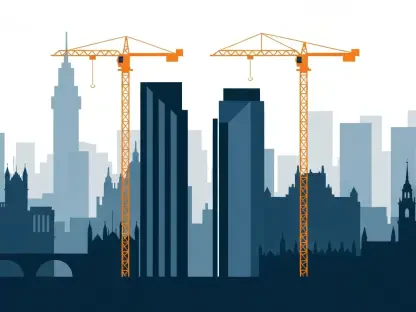In modern architecture and design, outdoor spaces have evolved from overlooked areas into essential components of contemporary living. This transformation is deeply rooted in the idea of seamlessly integrating outdoor environments with indoor living spaces, offering a holistic approach that harmonizes style, function, and comfort. The garden or backyard is no longer just an external setting; it is increasingly regarded as an extension of the home, with designers tasked with creating spaces that mirror the warmth and aesthetics found within interior rooms. By focusing on innovative design strategies and blending natural elements with sophisticated decor, the concept of inside/outside living emerges as a compelling trend, inviting homeowners to rethink how they engage with their outdoor surroundings.
The Seamless Transition from Indoors to Outdoors
Aesthetic Cohesion Through Thoughtful Design
A key factor in establishing a cohesive indoor-outdoor transition is the meticulous attention to design choices that ensure aesthetic symmetry and harmony. This approach involves using elements such as color palettes, textures, and materials that naturally flow from the interior to the exterior, creating a unified visual experience. Neutral colors often serve as the backbone of this design philosophy, setting a tranquil stage that complements both the vibrancy of nature and the modern elegance of interior décor. By employing a strategic selection of furniture and decorative elements, these outdoor spaces achieve a delicate balance between sophistication and tranquility, encouraging residents to engage with their environment in a more meaningful way.
Furthermore, the inclusion of artistic flooring options like encaustic concrete tiles, which mimic patterns typically found indoors, helps blend the boundaries between an outdoor patio and an indoor room. This meticulous approach not only adds depth and character to the design but also promotes a sense of inclusivity and flow, allowing homeowners to enjoy an uninterrupted aesthetic journey. Such design decisions emphasize the importance of visual continuity, making outdoor spaces vibrant extensions of the living area rather than disconnected parts of the property.
Integrating Functionality and Style
When creating a seamless transition between indoor and outdoor spaces, integrating functionality without sacrificing style is crucial. An outdoor kitchen and dining space exemplifies this balance, offering a practical yet elegantly styled environment perfect for entertaining or casual family gatherings. The design of such spaces often incorporates natural elements like stone or wood in a refined manner, highlighting the blend of utility and visual appeal. Open shelving units, for instance, provide accessible storage while maintaining a streamlined look that avoids the clutter typically associated with closed cabinets.
This intentional simplicity extends to aspects such as lighting and layout, which ensure that the space remains unobtrusive yet effective. The integration of pendant lights or lanterns helps illuminate the area, extending its usability into the evening while adding a touch of charm. Moreover, the outdoor kitchen’s design seamlessly merges with the surroundings, echoing a broader principle that outdoor areas should complement their environment rather than dominate it. Such a careful blend of form and function achieves a harmonious living space that enhances the overall utility and enjoyment of the outdoor environment.
Enhancing Livability and Comfort Outdoors
The Role of Textile and Furniture Choices
Creating an inviting and comfortable outdoor space requires careful selection of furniture and textiles, which play an important role in transforming a mere yard into a livable area as welcoming as any indoor room. The choice of materials and textures in these outdoor settings is pivotal; for example, knotted designs in sofas introduce tactile comfort, encouraging guests to relax and enjoy the surroundings. Dining chairs that incorporate complementary colors against a neutral backdrop further enhance the vibrancy and warmth of the space, making it not only visually appealing but also functionally superior.
To underscore comfort, furniture arrangements often follow an intuitive layout that fosters both social interaction and personal relaxation. Mixing weather-resistant materials with plush textiles addresses the unique demands of outdoor environments, ensuring longevity and continual aesthetic appeal. This thoughtful choice reflects a broader design trend, wherein outdoor spaces serve multifunctional purposes, accommodating everything from quiet solitude to lively gatherings. By focusing on these elements, designers effectively invite residents to immerse themselves in an outdoor ambiance that is both aesthetically pleasing and incredibly comfortable.
Strategic Lighting Choices
Lighting is a central component in extending the usability of outdoor areas, particularly during evening hours. Selecting lighting solutions that blend aesthetic appeal with functionality helps transform these spaces into extensions of the home even after sunset. Hanging lanterns or strategically placed ambient lights highlight the natural beauty of the environment while ensuring practical illumination for activities. This attention to detail aligns with contemporary trends aiming to maximize the functionality of every inch of space without compromising on style.
The lighting design often revolves around enhancing specific areas, such as dining zones or seating arrangements, providing both practical brightness and a captivating glow. Well-positioned lights not only facilitate late-night socializing but also contribute to the overall architectural elegance of the space. This synergy between form and function illustrates the design mantra that outdoor spaces should be as versatile as indoor ones, ultimately reflecting the home’s personality and accommodating diverse lifestyle needs.
Crafting a Unified In- and Outdoors Environment
Layering Decor and Landscaping
The final touch in integrating indoor and outdoor spaces lies in the thoughtful layering of décor and landscaping elements. Engaging with natural features, such as potted plants and strategically placed greenery, helps anchor the outdoor environment in its natural context while simultaneously adding visual interest. The careful arrangement of these elements creates a curated space that maintains a sense of order without overwhelming the visual senses. Placing plants around key areas such as the outdoor fireplace serves both aesthetic and practical purposes, warming up the space and inviting relaxation.
This layered approach combines carefully chosen decor pieces with organic elements, generating a cohesive ambiance that enhances the living experience. The attention to detail in arranging these components reflects a broader trend in design, where outdoor areas are treated with the same consideration as indoor spaces. The deliberate inclusion of natural features invites serenity and maintains a coherent theme throughout the property, ensuring that the outdoor space serves as a true extension of the home.
Embracing Modern Design Trends
Creating a seamless indoor-outdoor transition hinges on carefully chosen design elements that maintain aesthetic harmony and consistency. The aim is to integrate colors, textures, and materials that flow from inside to outside, presenting a cohesive visual narrative. Neutral color schemes are often pivotal in this design, offering a calm backdrop that enhances both the natural world outside and the chic style of indoor spaces. Thoughtfully chosen furnishings and decor contribute to a refined yet peaceful atmosphere outdoors, inviting people to connect more deeply with their surroundings.
Additionally, artistic flooring elements like encaustic concrete tiles emulate interior patterns, effectively bridging outdoor areas like patios with indoor spaces. This thoughtful planning adds depth and character while encouraging a fluid and inclusive design experience. Such design strategies underscore the necessity of visual consistency, transforming outdoor areas into lively extensions of the home rather than separate, disconnected segments. By doing so, residents can enjoy a continuous and harmonious aesthetic journey.









